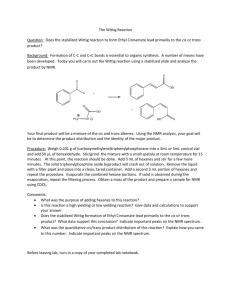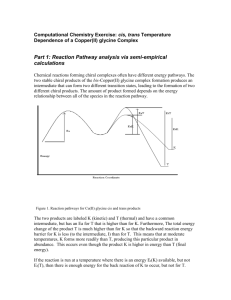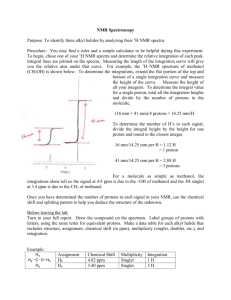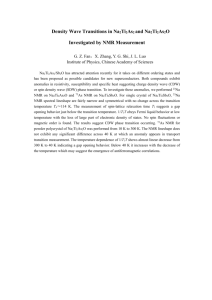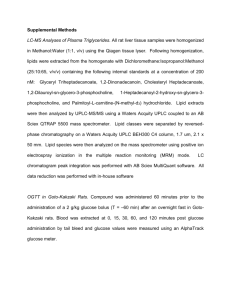lab report
advertisement
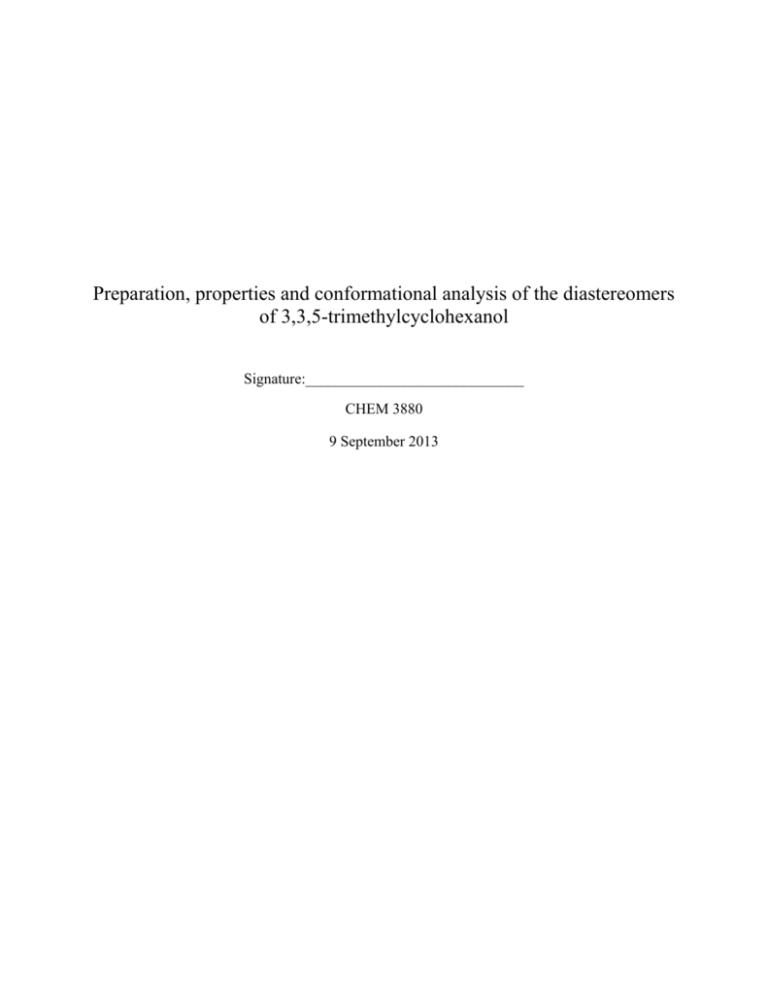
Preparation, properties and conformational analysis of the diastereomers of 3,3,5-trimethylcyclohexanol Signature:_____________________________ CHEM 3880 9 September 2013 Abstract: The goal of this experiment was to reduce a ketone with sodium borohydride to form a diastereomeric mixture of alcohols in order to separate the mixture by gas chromatography and analyze it by Proton Nuclear Magnetic Resonance spectroscopy (1H NMR) and Infrared spectroscopy (IR) to determine the abundance of isomers1. The goal was attained by first preparing cis and trans-3,3,5-trimethylcyclohexanol from 3,3,5-trimethylcyclohexanone using sodium borohydride (NaBH4) as the reducer in the presence of ethanol2. This was done in order to study the solvent effects on stereochemistry of the product composition. The 1H NMR spectra of the isomers was used to determine the abundance of isomers. Gas chromatography was then used to confirm the results obtained from NMR anlysis. For NMR, the pentet pattern is for trans which is at peak 3.5 and triplet of triplet pattern is for cis which is at peak 3.2. In GC, the two peaks – one with retention time 4.021 and the other with retention time around 4.134 stand for trans and cis isomers respectively. For NMR the trans % was 78.26% and the cis % was 21.74%. For GC the trans % was 81.6% and the cis % was 18.4%. Finally, NMR and GC were successfully used to analyze the alcohol mixture. Both these analytic methods gave roughly the same results and are powerful tools to analyze diastereomeric mixtures. Introduction: The objectives of this experiment were to: (1) to prepare cis and trans-3,3,5trimethylcyclohexanol from 3,3,5-trimethylcyclohexanone, (2) to study solvent effects on the stereochemistry of the product composition, (3) to obtain 1H NMR spectra of the isomers, (4) to determine the relative abundance of the isomers by NMR and gas chromatography and (5) to apply conformational analysis to the interpretation of the 1H NMR spectra of the diastereoisomers1. 1|Page Gas chromatography (GC) is a tool to separate, quantify and identify unknown organic compounds and permanent gases. The principle of GC requires a sample solution to be injected into the gas chromatography (GC) inlet where it is vaporized. The carrier gas then moves the vapor onto a chromatographic column. The sample flows through the column and the compounds are separated by their interaction with the stationary phase (column coating) and the mobile phase (carrier gas). Finally, the last part of the column passes through a heated transfer line and ends at the entrance to ion source. From there compounds eluting from the column are converted to ions and detected according to their mass to charge m/z ratio. The gas chromatograph uses a capillary column in which the stationary phase consists of silica. The CG consists of a carrier gas, gas controls, column, injector, detector and oven. A detector at the end of the column records the amount of time required for a given compound to elute off of the column. This allows similar compounds to be separated by GC such as isomers of dichlorobenzene, racemic cyclic ketone, or cis- and trans- fatty acids. So the amount of peak separation determines the analyte molecules (e.g. cis and trans isomers). GC used in conjunction with 1H NMR and infrared spectroscopy (IR) confirms the structure of organic compounds. Different groups show differences in energy between the axial and equatorial conformers. The differences in energy represent a measure of the steric bulk of the substituents. Single atoms are known to have little steric bulk. It is recognized that functional groups in an axial orientation are sterically more impeded than equatorial orientation. Literature shows that the trans isomer is represented a quintuplet and cis isomer is present as a triplet of triplets3. DO I NEED to SHOW Sodium Borohydride REDUCTION And Proposed mechanism of methanol ARE 2a and 2b trans and 3e and 3b cis isomers 2|Page 2a 2b 3e 3b Materials and Methods: Protocol was titled Preparation and properties of the diastereoisomers of 3,3,5trimethylcyclohexanol: conformational analysis and was obtained from CHEM 3880-A1 There were no deviations from the suggested procedure. The deuterated solvent was chloroform for NMR and the solvent was methanol for GC. Results: The integration value is the area under the peak. In GC, the area of a peak is proportional to amount of the compound that is present. The percent composition of the NMR analysis and GC analysis for trans and cis are listed in Table I. The average for methanol was calculated and is listed in Table II. The percent deviation of the methanol average to experiment 6 is shown in Table III. Experiment 17 did not have valid results and experiment 18 resulted in no product. 3|Page Table I: Percent composition of the NMR analysis and GC analysis for trans and cis. Experiment # 1 2 3 4 5 6 7 7 9 10 11 12 13 14 15 16 17 18 Rxn. Solvent methanol methanol methanol methanol methanol methanol ethanol ethanol ethanol ethanol ethanol ethanol 2-propanol 2-propanol 2-propanol 2-propanol 2-propanol 2-propanol NMR analysis – trans (%) 97.1 87.0 84.6 76.9 69.5 78.3 78.6 76.9 74.1 73.5 71.4 60.0 71.4 62.5 55.0 NMR analysis – cis (%) 2.9 13.0 15.4 23.1 30.5 21.7 21.4 23.1 25.9 26.5 28.6 40.0 28.6 37.5 45.0 GC analysis – trans (%) 81.2 89.0 78.1 81.0 72.0 81.6 69.9 70.4 70.4 67.0 65.6 68.9 61.0 63.3 57.3 55.8 GC analysis – cis (%) 18.8 11.0 21.9 19.0 28.0 18.4 30.1 29.6 29.6 33.0 34.4 31.1 39.0 36.7 42.7 44.2 invalid results no product Table II: Percent composition of methanol for NMR analysis and GC analysis for trans and cis with average. Experiment # 1 2 3 4 5 6 Average Rxn. Solvent methanol methanol methanol methanol methanol methanol methanol NMR analysis – trans (%) 97.1 87.0 84.6 76.9 69.5 78.3 82.2 NMR analysis – cis (%) 2.9 13.0 15.4 23.1 30.5 21.7 17.8 GC analysis – trans (%) 81.2 89.0 78.1 81.0 72.0 81.6 80.5 GC analysis – cis (%) 18.8 11.0 21.9 19.0 28.0 18.4 19.5 Table III: Percent deviation of experiment 6 from the average methanol of the NMR analysis and GC analysis for trans and cis. Experiment # 6 Deviation Rxn. Solvent methanol methanol NMR analysis – trans (%) 78.3 -4.8 NMR analysis – cis (%) 21.7 22.1 GC analysis – trans (%) 81.6 1.4 GC analysis – cis (%) 18.4 -5.7 4|Page Calculations: GC The area of a peak is proportional to amount of the compound that is present. The area can be approximated by treating the peak as a triangle. The area of a triangle is calculated by multiplying the height of the peak times its width at half height. To find the % of each isomer, the formula (Area/total area) x 100% was used. Peak at retention time 1.007 trans 3203317569/3924845246 = 0.816264*100 % = 81.6% Peak at retention time 4.021 & 4.134 cis Area (of both peaks added together)/total area x 100% (585993781+134228047)/3924845246 = 0.183503*100% = 18.3% NMR To find the % of each isomer divide the area by the total area. The ratio for peaks at 3.5 = 0.47/1.69 x 1.23 = 0.34 The ratio for peaks at 3.2 = 0.15/1.69 x 1.23 = 0.11 Next, sum all areas to find total area = 1.23 + 0.34 + 0.11 + 0.94 + 1.65 + 6.16 + 17.03 = 27.46 % of trans = 1.23 / 27.46 = 4.48% % of cis = 0.34 / 27.46 = 1.24% The ratio trans: cis = 3.6: 1 therefore, Trans % = 3.6 / 4.6 = 78.26% Cis % = 1/4.6 = 21.74% Discussion: The resulting percentages for methanol were consistent with the average results of the other experimenters as presented in Table II. The average NMR trans was 82.2% which was only 5|Page 4.7% deviation from my result. The NMR cis was significantly different at 22.1% but there was an outlier with a reported cis value of 2.9%. GC analysis for both trans and cis showed insignificant percent deviation of 1.3% and -5.72% respectively from my result. Both GC and NMR analysis confirm that the major product is the trans isomer. Next, my results (experiment 6) compared to the average using other solvents, it suggests that the general result, that trans is the predominant isomer still holds good. The ratio of trans : cis is quite different among the solvents, suggesting that there is a solvent effect on the reaction outcome. There is a steady decrease in the percentage of trans as you go from methanol to 2-propanol. The polarity decreases as you go from methanol to 2-propanol. Alcohol impacts reactivity and diastereoselectivity. As 2a is more stable than 2e for trans, the trans isomer exists primarily in 2a form. When this ionizes, solvation will be sterically hindered and hence the equilibrium will shift to the undissociated alcohol making this a weaker acid. For the cis, 3e is preferred. When this ionizes, solvation is not hindered and hence equilibrium is shifted to the dissociated alcohol. (Solvation will be hindered when the OH group is axial due to 1,3-diaxial interactions). Hence the cis isomer is the stronger acid. Therefore in reactions, the cis isomer would react more quickly in the presence of weak bases compared to the trans. When considering steric bulk, the trans alcohol is bulkier coupled with the 1,3-diaxial interactions with axial OH. Depending on reactions, this may react faster to relieve the diaxial strain like in oxidation. Otherwise, it may actually react slowly if strain is not relieved. The transition state for axial attack is hindered and less energetically less favorable. This is because the top face is sterically hindered for attack by BH4- due to the presence of the axial methyl group. 6|Page The significance of the results suggests that NMR and GC were successfully used to analyze the alcohol mixture. Both these analytic methods gave roughly the same results and are powerful tools to analyze diastereomeric mixtures. The analysis gives insight into the possible mechanistic pathways that the reaction occurs by. References: 2. Haubenstock, H.; Davidson, E. J. Org. Chem., 1963, 28, 2772-2775. 3. Eliel, E. L.; Sshroeter, S.H. J. Am. Chem Soc. 1965, 87, 5031-5038. 7|Page
